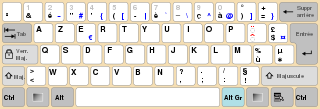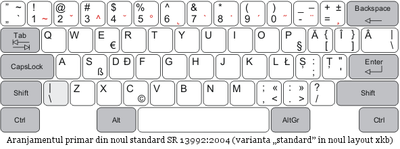
A diacritic is a glyph added to a letter or to a basic glyph. The term derives from the Ancient Greek διακριτικός, from διακρίνω. The word diacritic is a noun, though it is sometimes used in an attributive sense, whereas diacritical is only an adjective. Some diacritics, such as the acute ⟨á⟩, grave ⟨à⟩, and circumflex ⟨â⟩, are often called accents. Diacritics may appear above or below a letter or in some other position such as within the letter or between two letters.

QWERTY is a keyboard layout for Latin-script alphabets. The name comes from the order of the first six keys on the top letter row of the keyboard. The QWERTY design is based on a layout created for the Sholes and Glidden typewriter and sold to E. Remington and Sons in 1873. It became popular with the success of the Remington No. 2 of 1878, and remains in ubiquitous use.
A cedilla, or cedille, is a hook or tail added under certain letters as a diacritical mark to modify their pronunciation. In Catalan, French, and Portuguese it is used only under the letter c, and the entire letter is called, respectively, c trencada, c cédille, and c cedilhado. It is used to mark vowel nasalization in many languages of sub-Saharan Africa, including Vute from Cameroon.

Ç or ç (C-cedilla) is a Latin script letter used in the Albanian, Azerbaijani, Manx, Tatar, Turkish, Turkmen, Kurdish, Kazakh, and Romance alphabets. Romance languages that use this letter include Catalan, French, Portuguese, and Occitan, as a variant of the letter C with a cedilla. It is also occasionally used in Crimean Tatar and in Tajik to represent the sound. It is often retained in the spelling of loanwords from any of these languages in English, Basque, Dutch, Spanish and other languages using the Latin alphabet.
ISO/IEC 8859-2:1999, Information technology — 8-bit single-byte coded graphic character sets — Part 2: Latin alphabet No. 2, is part of the ISO/IEC 8859 series of ASCII-based standard character encodings, first edition published in 1987. It is informally referred to as "Latin-2". It is generally intended for Central or "Eastern European" languages that are written in the Latin script. Note that ISO/IEC 8859-2 is very different from code page 852 which is also referred to as "Latin-2" in Czech and Slovak regions. Code page 912 is an extension. Almost half the use of the encoding is for Polish, and it's the main legacy encoding for Polish, while virtually all use of it has been replaced by UTF-8.

S-cedilla is a letter used in some of the Turkic languages. It occurs in the Azerbaijani, Gagauz, Turkish, and Turkmen alphabets. It is also planned to be in the Latin-based Kazakh alphabet. It is used in Brahui, Chechen, Crimean Tatar, Kurdish, and Tatar as well, when they are written in the Latin alphabet.

The QWERTZ or QWERTZU keyboard is a typewriter and keyboard layout widely used in Central Europe. The name comes from the first six letters at the top left of the keyboard:.

AZERTY is a specific layout for the characters of the Latin alphabet on typewriter keys and computer keyboards. The layout takes its name from the first six letters to appear on the first row of alphabetical keys; that is,. Similar to the QWERTZ layout, it is modelled on the English QWERTY layout. It is used in France and Belgium, although each of these countries has its own national variation on the layout. Luxembourg and Switzerland use the Swiss QWERTZ keyboard. Most of the residents of Quebec, the mainly French-speaking province of Canada, use a QWERTY keyboard that has been adapted to the French language such as the Multilingual Standard keyboard CAN/CSA Z243.200-92 which is stipulated by the government of Quebec and the Government of Canada.

The Romanian alphabet is a variant of the Latin alphabet used for writing the Romanian language. It is a modification of the classical Latin alphabet and consists of 31 letters, five of which have been modified from their Latin originals for the phonetic requirements of the language:
The International Alphabet of Sanskrit Transliteration (IAST) is a transliteration scheme that allows the lossless romanisation of Indic scripts as employed by Sanskrit and related Indic languages. It is based on a scheme that emerged during the 19th century from suggestions by Charles Trevelyan, William Jones, Monier Monier-Williams and other scholars, and formalised by the Transliteration Committee of the Geneva Oriental Congress, in September 1894. IAST makes it possible for the reader to read the Indic text unambiguously, exactly as if it were in the original Indic script. It is this faithfulness to the original scripts that accounts for its continuing popularity amongst scholars.

ArmSCII or ARMSCII is a set of obsolete single-byte character encodings for the Armenian alphabet defined by Armenian national standard 166–9. ArmSCII is an acronym for Armenian Standard Code for Information Interchange, similar to ASCII for the American standard. It has been superseded by the Unicode standard.

S-comma is a letter which is part of the Romanian alphabet, used to represent the sound, the voiceless postalveolar fricative. S-comma consists of an s with a diacritical comma underneath it, and is distinct from s-cedilla.

T-comma is a letter which consists of a t with a diacritical comma underneath it, and is distinct from s-cedilla. It is part of the Romanian alphabet, used to represent the Romanian language sound, the voiceless alveolar affricate. The letter is also a part of the Finno-Ugric Livonian language alphabet, representing the sound.
T-cedilla is a letter which is part of the Gagauz alphabet, used to represent the Gagauz language sound, the voiceless alveolar affricate. It is written as the letter T with a cedilla below and it has both the lower-case (U+0163) and the upper-case variants (U+0162). It is also used in the Manjak and Mankanya language for.

A Hebrew keyboard comes in two different keyboard layouts. Most Hebrew keyboards are bilingual, with Latin characters, usually in a US Qwerty layout. Trilingual keyboard options also exist, with the third script being Arabic or Russian, due to the sizable Arabic- and Russian-speaking populations in Israel.

D-comma is a letter that was part of the Romanian alphabet to represent the sound or if it was derived from a Latin d. It was the equivalent of the Cyrillic letters З and Ѕ.
The programming language APL uses a number of symbols, rather than words from natural language, to identify operations, similarly to mathematical symbols. Prior to the wide adoption of Unicode, a number of special-purpose EBCDIC and non-EBCDIC code pages were used to represent the symbols required for writing APL.

A keyboard layout is any specific physical, visual or functional arrangement of the keys, legends, or key-meaning associations (respectively) of a computer keyboard, mobile phone, or other computer-controlled typographic keyboard.
There are a number of methods to input Esperanto letters and text on a computer, e.g. when using a word processor or email. Input methods depend on a computer's operating system. Specifically the characters ĵ, ĝ, ĉ, ĥ, ŭ, ŝ can be problematic.















